HR Report: Cross-Cultural Management and Employee Involvement Strategy
VerifiedAdded on 2022/10/01
|19
|3952
|184
Report
AI Summary
This report analyzes the challenges and opportunities of managing a diverse workforce across China, India, and the United States, focusing on employee involvement strategies. It utilizes Hofstede's cultural dimensions to highlight cultural differences and their impact on employee motivation, teamwork, and overall work performance. The report addresses issues such as miscommunication, differing expectations, and variations in work styles, offering recommendations to improve employee satisfaction and foster better coordination within cross-cultural teams. Key recommendations include open communication channels, the development of collectivist cultures, and the adoption of learning tools to enhance cultural awareness. The report also emphasizes the importance of understanding communication styles, addressing potential conflicts, and creating an inclusive environment to retain top talent and drive innovation. This report is a detailed analysis of cross-cultural management and offers strategies for creating a cohesive and productive global workforce.
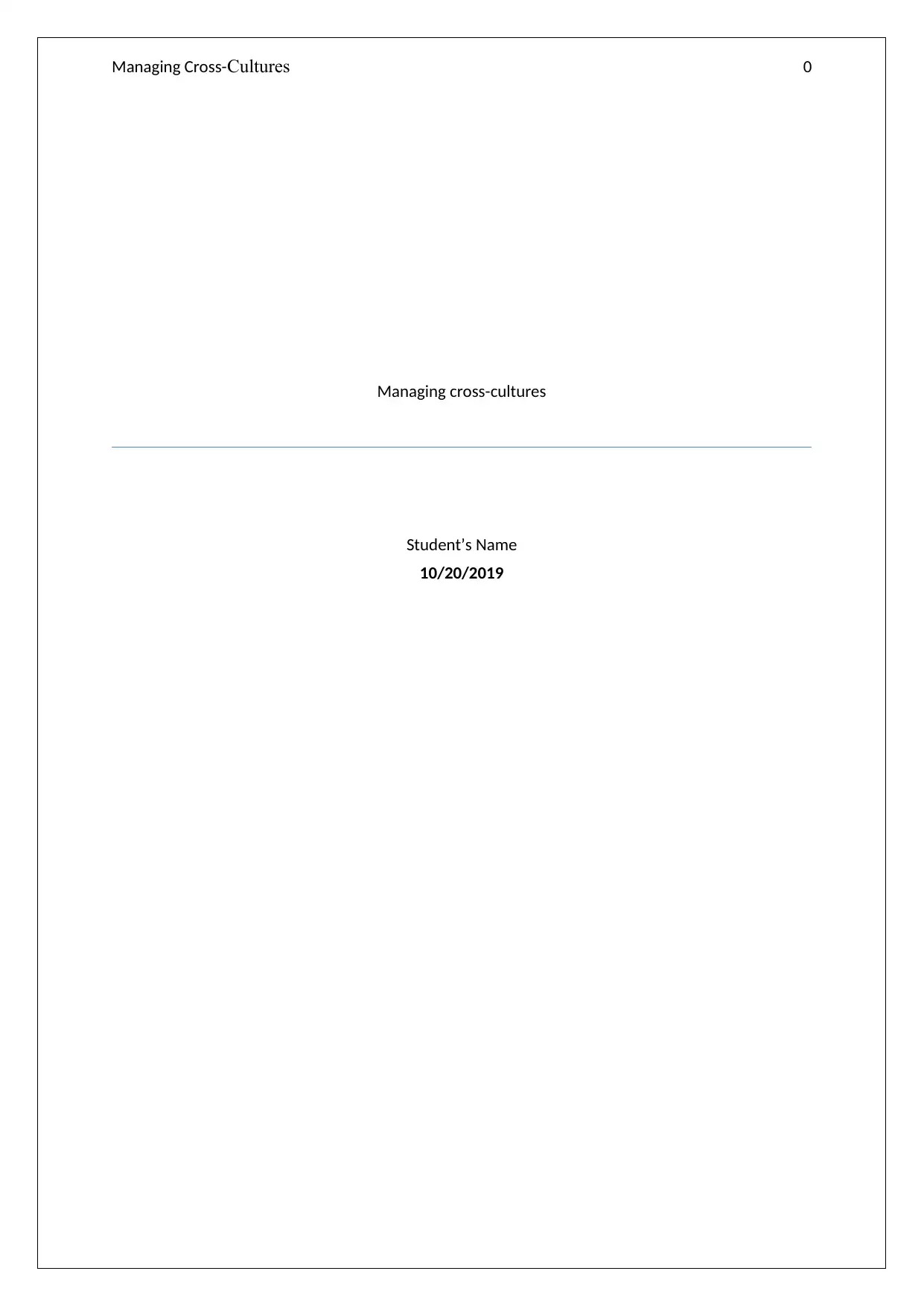
Managing Cross-Cultures 0
Managing cross-cultures
Student’s Name
10/20/2019
Managing cross-cultures
Student’s Name
10/20/2019
Paraphrase This Document
Need a fresh take? Get an instant paraphrase of this document with our AI Paraphraser
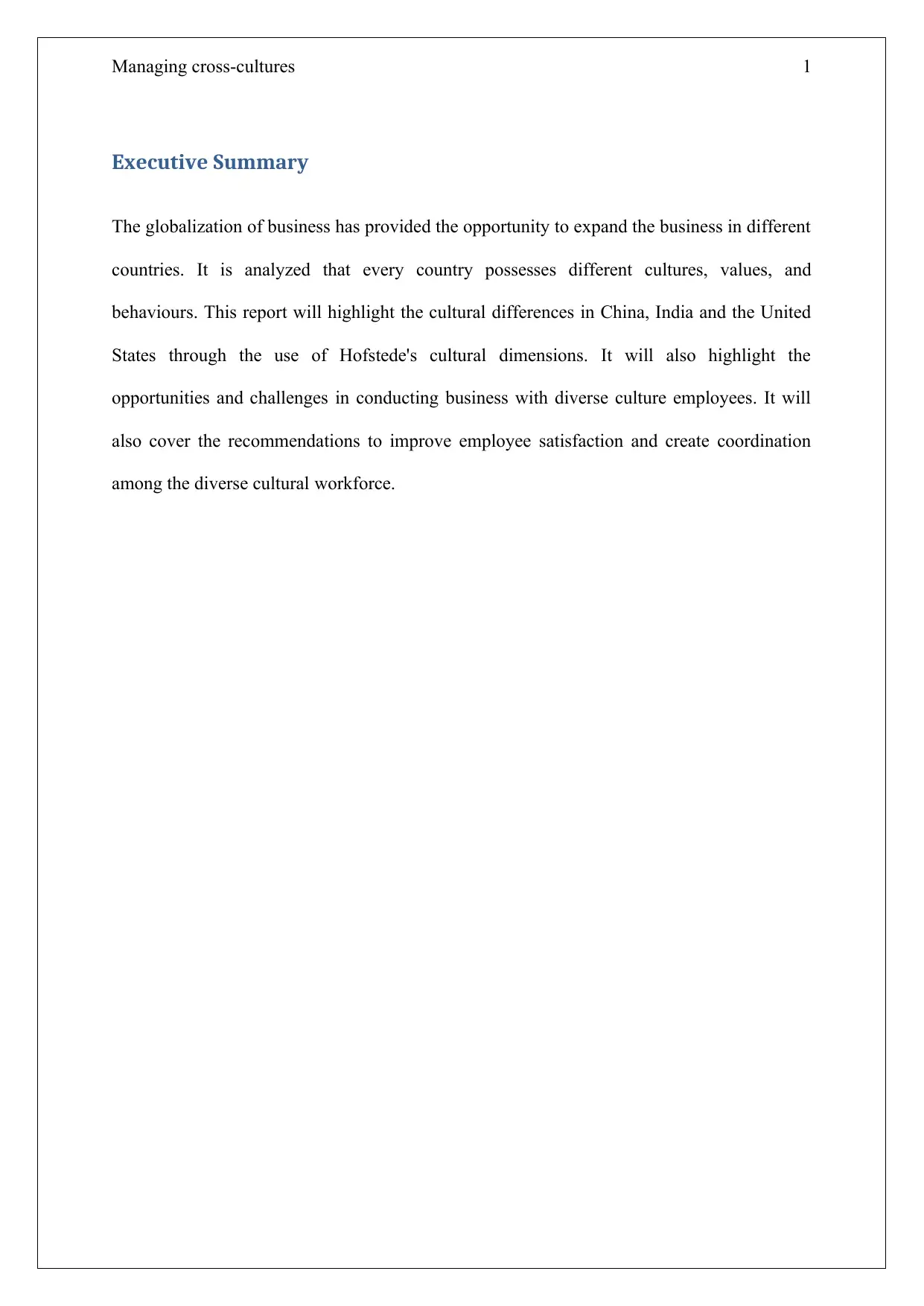
Managing cross-cultures 1
Executive Summary
The globalization of business has provided the opportunity to expand the business in different
countries. It is analyzed that every country possesses different cultures, values, and
behaviours. This report will highlight the cultural differences in China, India and the United
States through the use of Hofstede's cultural dimensions. It will also highlight the
opportunities and challenges in conducting business with diverse culture employees. It will
also cover the recommendations to improve employee satisfaction and create coordination
among the diverse cultural workforce.
Executive Summary
The globalization of business has provided the opportunity to expand the business in different
countries. It is analyzed that every country possesses different cultures, values, and
behaviours. This report will highlight the cultural differences in China, India and the United
States through the use of Hofstede's cultural dimensions. It will also highlight the
opportunities and challenges in conducting business with diverse culture employees. It will
also cover the recommendations to improve employee satisfaction and create coordination
among the diverse cultural workforce.
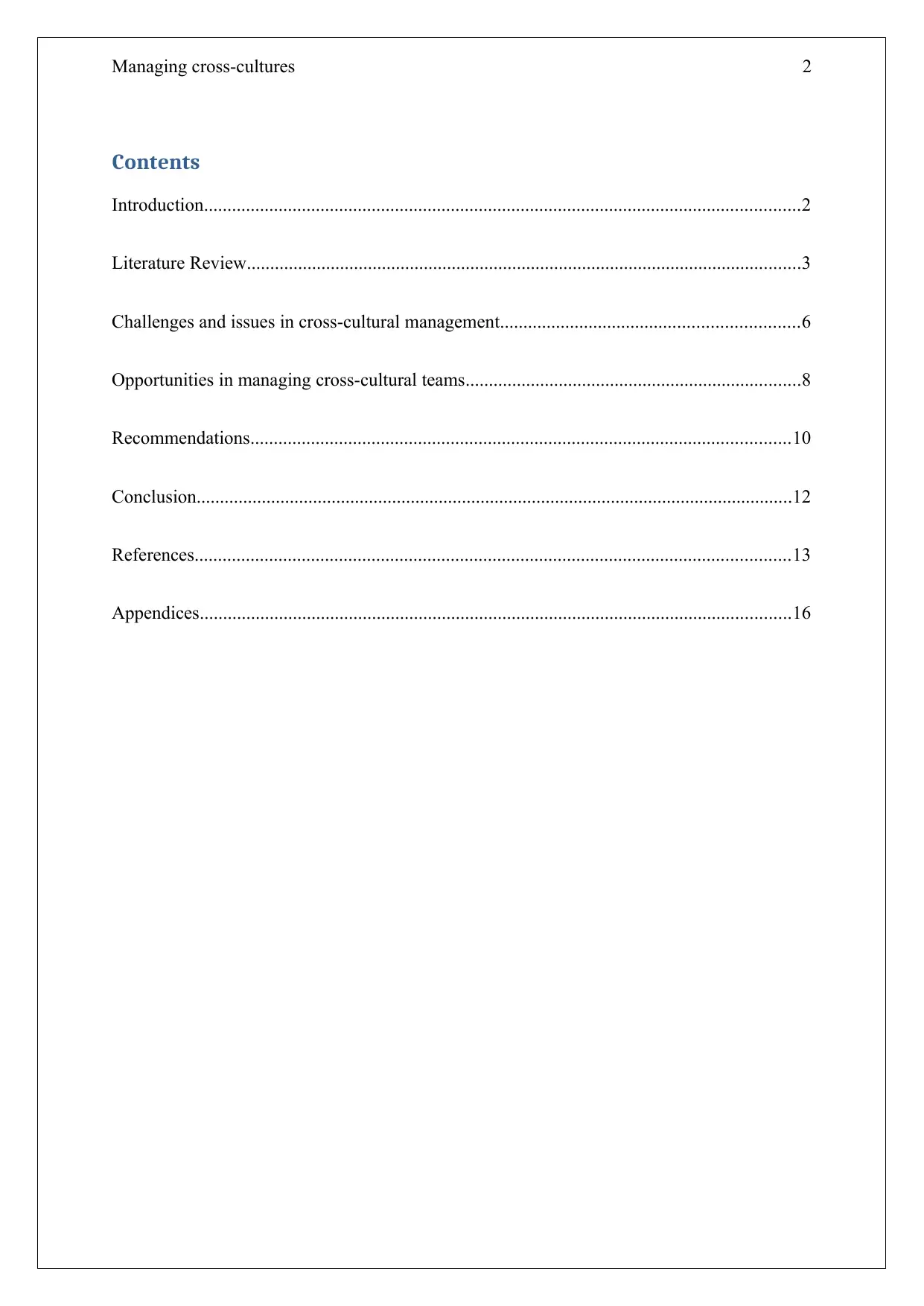
Managing cross-cultures 2
Contents
Introduction................................................................................................................................2
Literature Review.......................................................................................................................3
Challenges and issues in cross-cultural management................................................................6
Opportunities in managing cross-cultural teams........................................................................8
Recommendations....................................................................................................................10
Conclusion................................................................................................................................12
References................................................................................................................................13
Appendices...............................................................................................................................16
Contents
Introduction................................................................................................................................2
Literature Review.......................................................................................................................3
Challenges and issues in cross-cultural management................................................................6
Opportunities in managing cross-cultural teams........................................................................8
Recommendations....................................................................................................................10
Conclusion................................................................................................................................12
References................................................................................................................................13
Appendices...............................................................................................................................16
⊘ This is a preview!⊘
Do you want full access?
Subscribe today to unlock all pages.

Trusted by 1+ million students worldwide
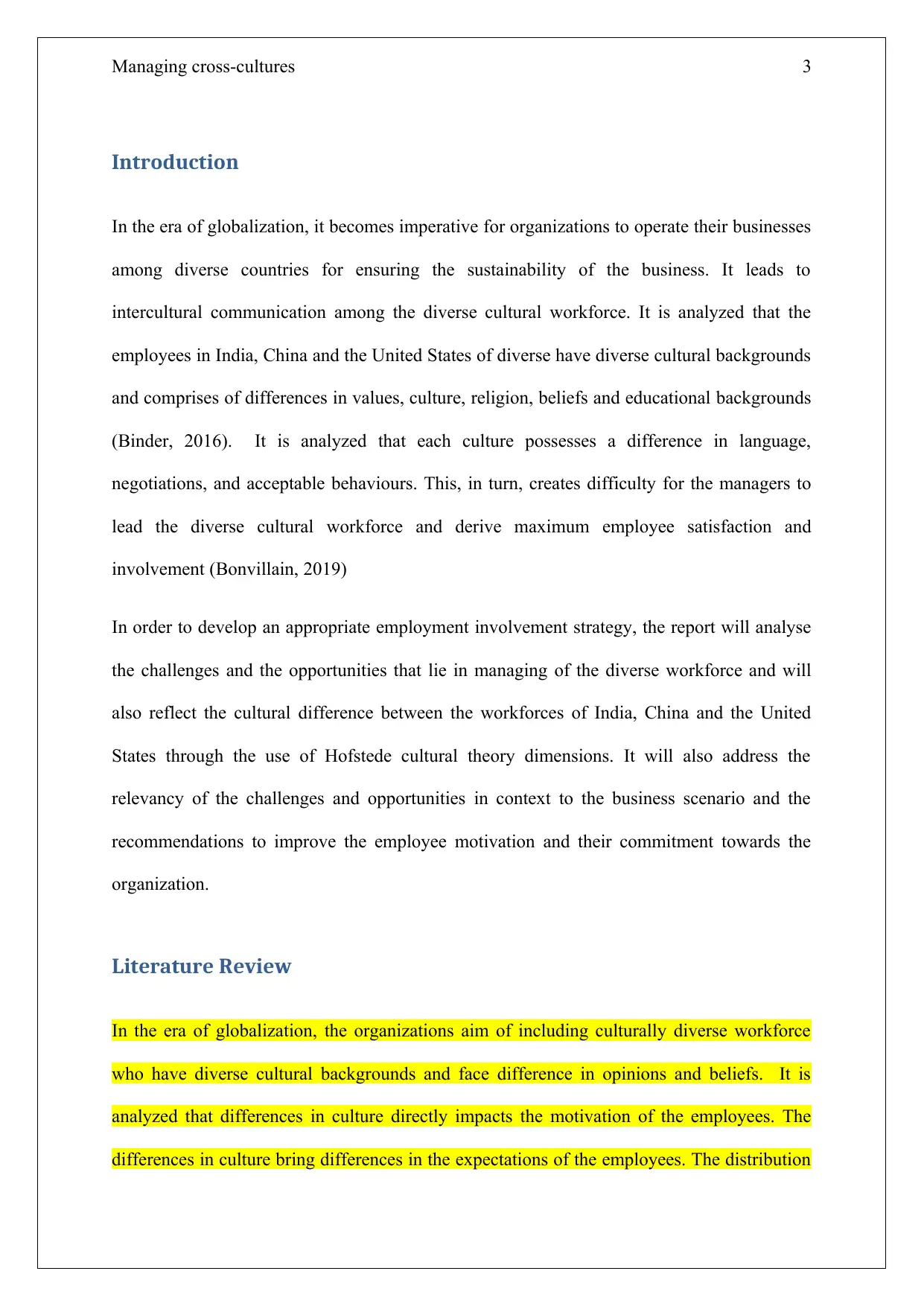
Managing cross-cultures 3
Introduction
In the era of globalization, it becomes imperative for organizations to operate their businesses
among diverse countries for ensuring the sustainability of the business. It leads to
intercultural communication among the diverse cultural workforce. It is analyzed that the
employees in India, China and the United States of diverse have diverse cultural backgrounds
and comprises of differences in values, culture, religion, beliefs and educational backgrounds
(Binder, 2016). It is analyzed that each culture possesses a difference in language,
negotiations, and acceptable behaviours. This, in turn, creates difficulty for the managers to
lead the diverse cultural workforce and derive maximum employee satisfaction and
involvement (Bonvillain, 2019)
In order to develop an appropriate employment involvement strategy, the report will analyse
the challenges and the opportunities that lie in managing of the diverse workforce and will
also reflect the cultural difference between the workforces of India, China and the United
States through the use of Hofstede cultural theory dimensions. It will also address the
relevancy of the challenges and opportunities in context to the business scenario and the
recommendations to improve the employee motivation and their commitment towards the
organization.
Literature Review
In the era of globalization, the organizations aim of including culturally diverse workforce
who have diverse cultural backgrounds and face difference in opinions and beliefs. It is
analyzed that differences in culture directly impacts the motivation of the employees. The
differences in culture bring differences in the expectations of the employees. The distribution
Introduction
In the era of globalization, it becomes imperative for organizations to operate their businesses
among diverse countries for ensuring the sustainability of the business. It leads to
intercultural communication among the diverse cultural workforce. It is analyzed that the
employees in India, China and the United States of diverse have diverse cultural backgrounds
and comprises of differences in values, culture, religion, beliefs and educational backgrounds
(Binder, 2016). It is analyzed that each culture possesses a difference in language,
negotiations, and acceptable behaviours. This, in turn, creates difficulty for the managers to
lead the diverse cultural workforce and derive maximum employee satisfaction and
involvement (Bonvillain, 2019)
In order to develop an appropriate employment involvement strategy, the report will analyse
the challenges and the opportunities that lie in managing of the diverse workforce and will
also reflect the cultural difference between the workforces of India, China and the United
States through the use of Hofstede cultural theory dimensions. It will also address the
relevancy of the challenges and opportunities in context to the business scenario and the
recommendations to improve the employee motivation and their commitment towards the
organization.
Literature Review
In the era of globalization, the organizations aim of including culturally diverse workforce
who have diverse cultural backgrounds and face difference in opinions and beliefs. It is
analyzed that differences in culture directly impacts the motivation of the employees. The
differences in culture bring differences in the expectations of the employees. The distribution
Paraphrase This Document
Need a fresh take? Get an instant paraphrase of this document with our AI Paraphraser
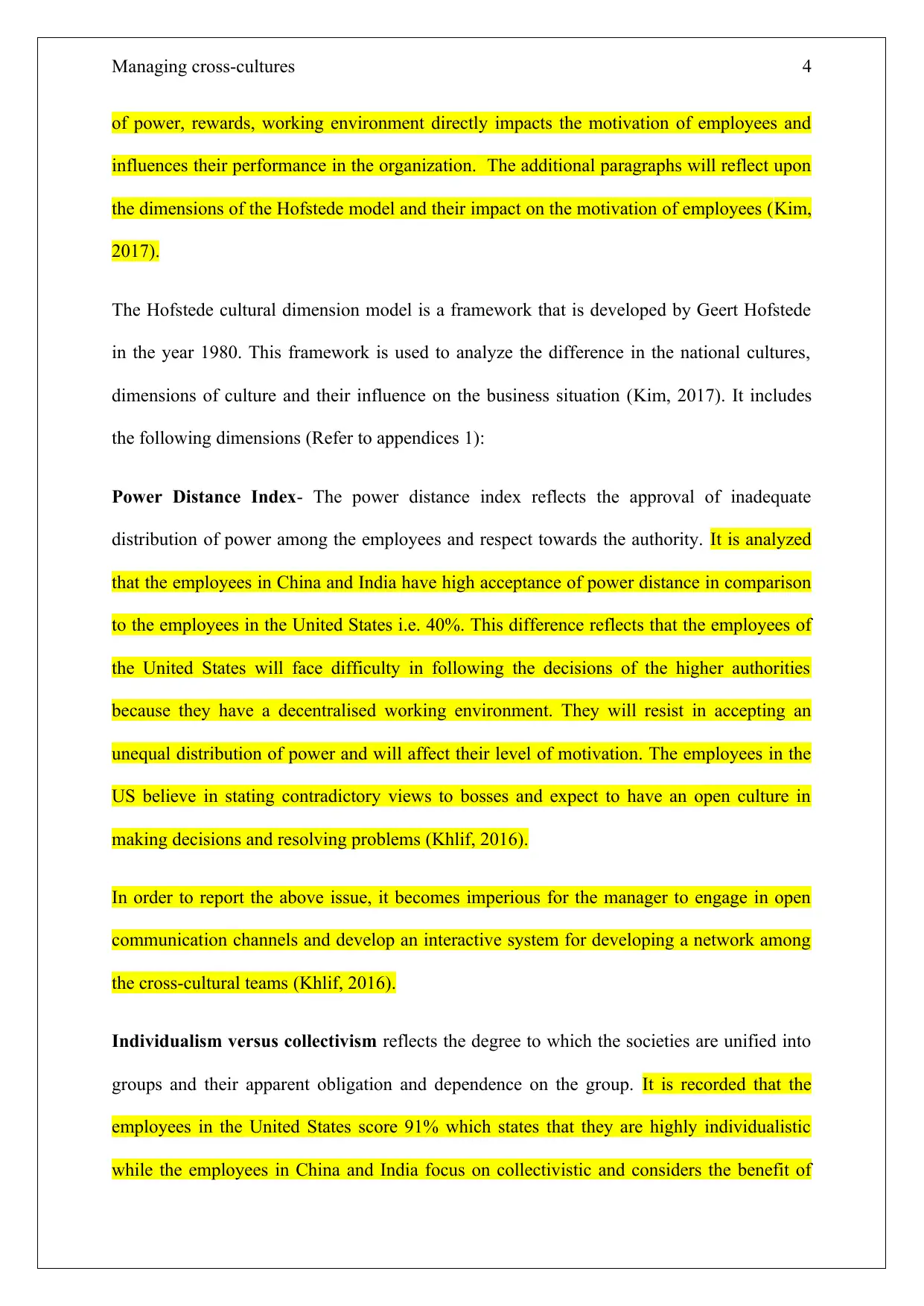
Managing cross-cultures 4
of power, rewards, working environment directly impacts the motivation of employees and
influences their performance in the organization. The additional paragraphs will reflect upon
the dimensions of the Hofstede model and their impact on the motivation of employees (Kim,
2017).
The Hofstede cultural dimension model is a framework that is developed by Geert Hofstede
in the year 1980. This framework is used to analyze the difference in the national cultures,
dimensions of culture and their influence on the business situation (Kim, 2017). It includes
the following dimensions (Refer to appendices 1):
Power Distance Index- The power distance index reflects the approval of inadequate
distribution of power among the employees and respect towards the authority. It is analyzed
that the employees in China and India have high acceptance of power distance in comparison
to the employees in the United States i.e. 40%. This difference reflects that the employees of
the United States will face difficulty in following the decisions of the higher authorities
because they have a decentralised working environment. They will resist in accepting an
unequal distribution of power and will affect their level of motivation. The employees in the
US believe in stating contradictory views to bosses and expect to have an open culture in
making decisions and resolving problems (Khlif, 2016).
In order to report the above issue, it becomes imperious for the manager to engage in open
communication channels and develop an interactive system for developing a network among
the cross-cultural teams (Khlif, 2016).
Individualism versus collectivism reflects the degree to which the societies are unified into
groups and their apparent obligation and dependence on the group. It is recorded that the
employees in the United States score 91% which states that they are highly individualistic
while the employees in China and India focus on collectivistic and considers the benefit of
of power, rewards, working environment directly impacts the motivation of employees and
influences their performance in the organization. The additional paragraphs will reflect upon
the dimensions of the Hofstede model and their impact on the motivation of employees (Kim,
2017).
The Hofstede cultural dimension model is a framework that is developed by Geert Hofstede
in the year 1980. This framework is used to analyze the difference in the national cultures,
dimensions of culture and their influence on the business situation (Kim, 2017). It includes
the following dimensions (Refer to appendices 1):
Power Distance Index- The power distance index reflects the approval of inadequate
distribution of power among the employees and respect towards the authority. It is analyzed
that the employees in China and India have high acceptance of power distance in comparison
to the employees in the United States i.e. 40%. This difference reflects that the employees of
the United States will face difficulty in following the decisions of the higher authorities
because they have a decentralised working environment. They will resist in accepting an
unequal distribution of power and will affect their level of motivation. The employees in the
US believe in stating contradictory views to bosses and expect to have an open culture in
making decisions and resolving problems (Khlif, 2016).
In order to report the above issue, it becomes imperious for the manager to engage in open
communication channels and develop an interactive system for developing a network among
the cross-cultural teams (Khlif, 2016).
Individualism versus collectivism reflects the degree to which the societies are unified into
groups and their apparent obligation and dependence on the group. It is recorded that the
employees in the United States score 91% which states that they are highly individualistic
while the employees in China and India focus on collectivistic and considers the benefit of
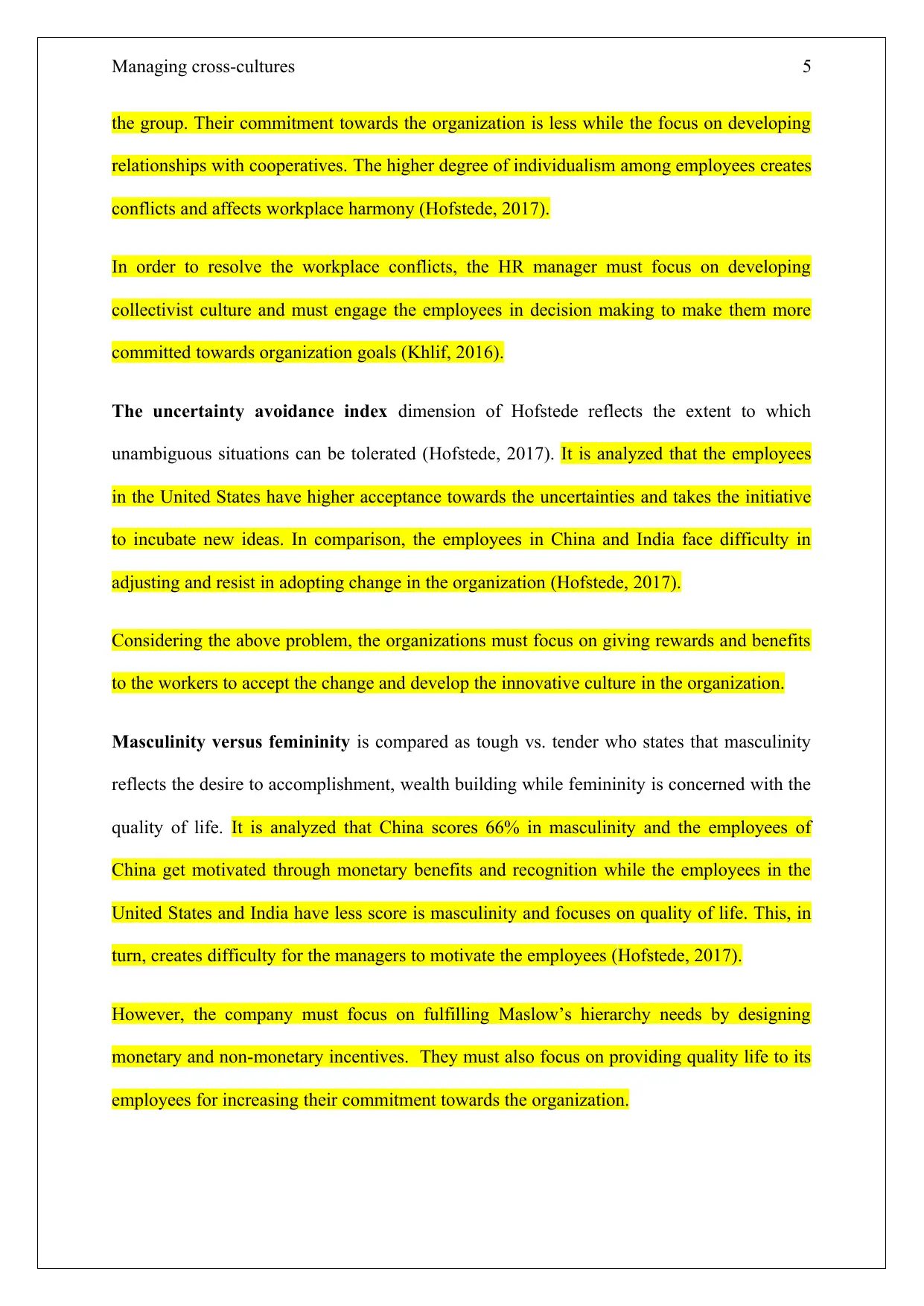
Managing cross-cultures 5
the group. Their commitment towards the organization is less while the focus on developing
relationships with cooperatives. The higher degree of individualism among employees creates
conflicts and affects workplace harmony (Hofstede, 2017).
In order to resolve the workplace conflicts, the HR manager must focus on developing
collectivist culture and must engage the employees in decision making to make them more
committed towards organization goals (Khlif, 2016).
The uncertainty avoidance index dimension of Hofstede reflects the extent to which
unambiguous situations can be tolerated (Hofstede, 2017). It is analyzed that the employees
in the United States have higher acceptance towards the uncertainties and takes the initiative
to incubate new ideas. In comparison, the employees in China and India face difficulty in
adjusting and resist in adopting change in the organization (Hofstede, 2017).
Considering the above problem, the organizations must focus on giving rewards and benefits
to the workers to accept the change and develop the innovative culture in the organization.
Masculinity versus femininity is compared as tough vs. tender who states that masculinity
reflects the desire to accomplishment, wealth building while femininity is concerned with the
quality of life. It is analyzed that China scores 66% in masculinity and the employees of
China get motivated through monetary benefits and recognition while the employees in the
United States and India have less score is masculinity and focuses on quality of life. This, in
turn, creates difficulty for the managers to motivate the employees (Hofstede, 2017).
However, the company must focus on fulfilling Maslow’s hierarchy needs by designing
monetary and non-monetary incentives. They must also focus on providing quality life to its
employees for increasing their commitment towards the organization.
the group. Their commitment towards the organization is less while the focus on developing
relationships with cooperatives. The higher degree of individualism among employees creates
conflicts and affects workplace harmony (Hofstede, 2017).
In order to resolve the workplace conflicts, the HR manager must focus on developing
collectivist culture and must engage the employees in decision making to make them more
committed towards organization goals (Khlif, 2016).
The uncertainty avoidance index dimension of Hofstede reflects the extent to which
unambiguous situations can be tolerated (Hofstede, 2017). It is analyzed that the employees
in the United States have higher acceptance towards the uncertainties and takes the initiative
to incubate new ideas. In comparison, the employees in China and India face difficulty in
adjusting and resist in adopting change in the organization (Hofstede, 2017).
Considering the above problem, the organizations must focus on giving rewards and benefits
to the workers to accept the change and develop the innovative culture in the organization.
Masculinity versus femininity is compared as tough vs. tender who states that masculinity
reflects the desire to accomplishment, wealth building while femininity is concerned with the
quality of life. It is analyzed that China scores 66% in masculinity and the employees of
China get motivated through monetary benefits and recognition while the employees in the
United States and India have less score is masculinity and focuses on quality of life. This, in
turn, creates difficulty for the managers to motivate the employees (Hofstede, 2017).
However, the company must focus on fulfilling Maslow’s hierarchy needs by designing
monetary and non-monetary incentives. They must also focus on providing quality life to its
employees for increasing their commitment towards the organization.
⊘ This is a preview!⊘
Do you want full access?
Subscribe today to unlock all pages.

Trusted by 1+ million students worldwide
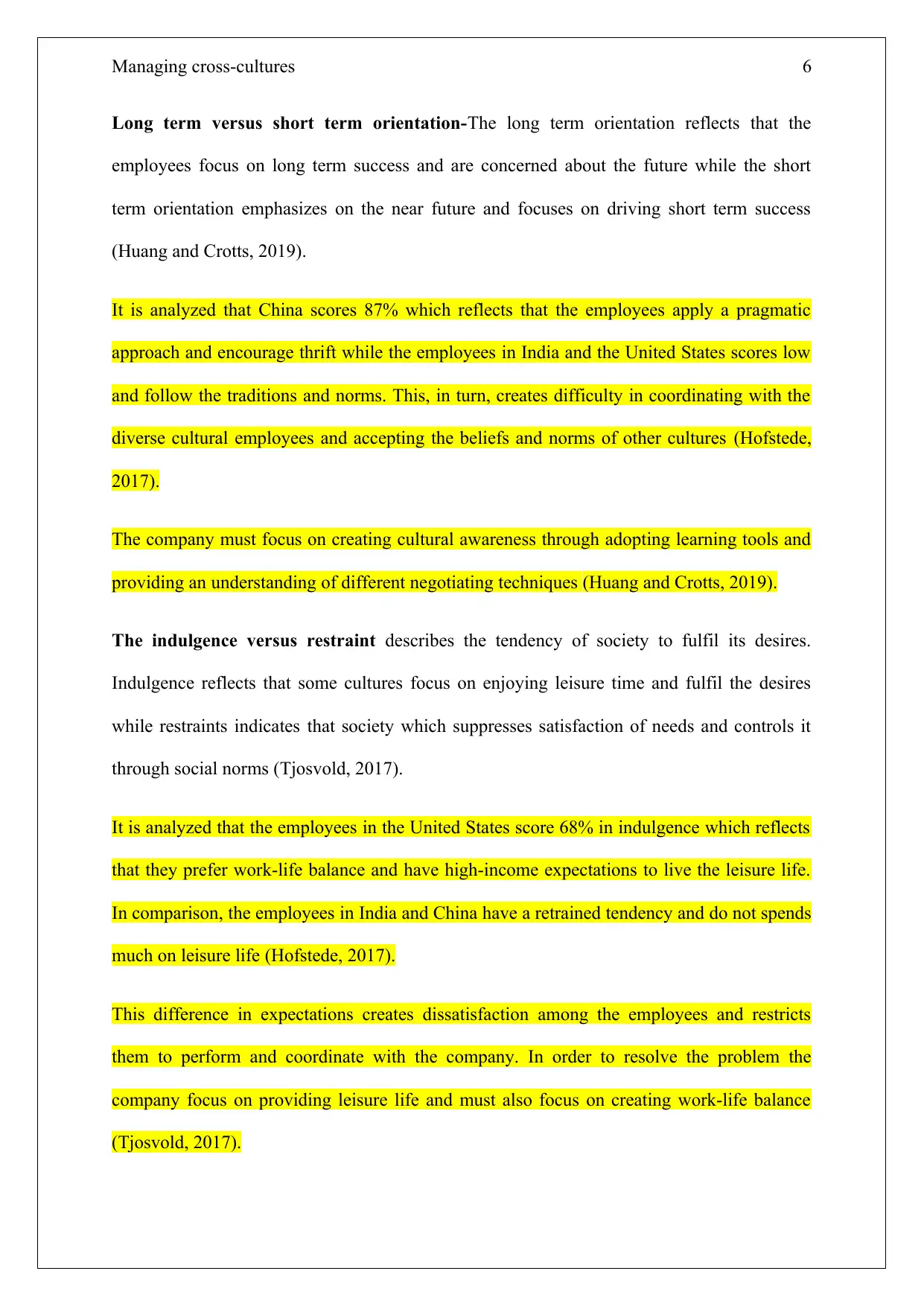
Managing cross-cultures 6
Long term versus short term orientation-The long term orientation reflects that the
employees focus on long term success and are concerned about the future while the short
term orientation emphasizes on the near future and focuses on driving short term success
(Huang and Crotts, 2019).
It is analyzed that China scores 87% which reflects that the employees apply a pragmatic
approach and encourage thrift while the employees in India and the United States scores low
and follow the traditions and norms. This, in turn, creates difficulty in coordinating with the
diverse cultural employees and accepting the beliefs and norms of other cultures (Hofstede,
2017).
The company must focus on creating cultural awareness through adopting learning tools and
providing an understanding of different negotiating techniques (Huang and Crotts, 2019).
The indulgence versus restraint describes the tendency of society to fulfil its desires.
Indulgence reflects that some cultures focus on enjoying leisure time and fulfil the desires
while restraints indicates that society which suppresses satisfaction of needs and controls it
through social norms (Tjosvold, 2017).
It is analyzed that the employees in the United States score 68% in indulgence which reflects
that they prefer work-life balance and have high-income expectations to live the leisure life.
In comparison, the employees in India and China have a retrained tendency and do not spends
much on leisure life (Hofstede, 2017).
This difference in expectations creates dissatisfaction among the employees and restricts
them to perform and coordinate with the company. In order to resolve the problem the
company focus on providing leisure life and must also focus on creating work-life balance
(Tjosvold, 2017).
Long term versus short term orientation-The long term orientation reflects that the
employees focus on long term success and are concerned about the future while the short
term orientation emphasizes on the near future and focuses on driving short term success
(Huang and Crotts, 2019).
It is analyzed that China scores 87% which reflects that the employees apply a pragmatic
approach and encourage thrift while the employees in India and the United States scores low
and follow the traditions and norms. This, in turn, creates difficulty in coordinating with the
diverse cultural employees and accepting the beliefs and norms of other cultures (Hofstede,
2017).
The company must focus on creating cultural awareness through adopting learning tools and
providing an understanding of different negotiating techniques (Huang and Crotts, 2019).
The indulgence versus restraint describes the tendency of society to fulfil its desires.
Indulgence reflects that some cultures focus on enjoying leisure time and fulfil the desires
while restraints indicates that society which suppresses satisfaction of needs and controls it
through social norms (Tjosvold, 2017).
It is analyzed that the employees in the United States score 68% in indulgence which reflects
that they prefer work-life balance and have high-income expectations to live the leisure life.
In comparison, the employees in India and China have a retrained tendency and do not spends
much on leisure life (Hofstede, 2017).
This difference in expectations creates dissatisfaction among the employees and restricts
them to perform and coordinate with the company. In order to resolve the problem the
company focus on providing leisure life and must also focus on creating work-life balance
(Tjosvold, 2017).
Paraphrase This Document
Need a fresh take? Get an instant paraphrase of this document with our AI Paraphraser
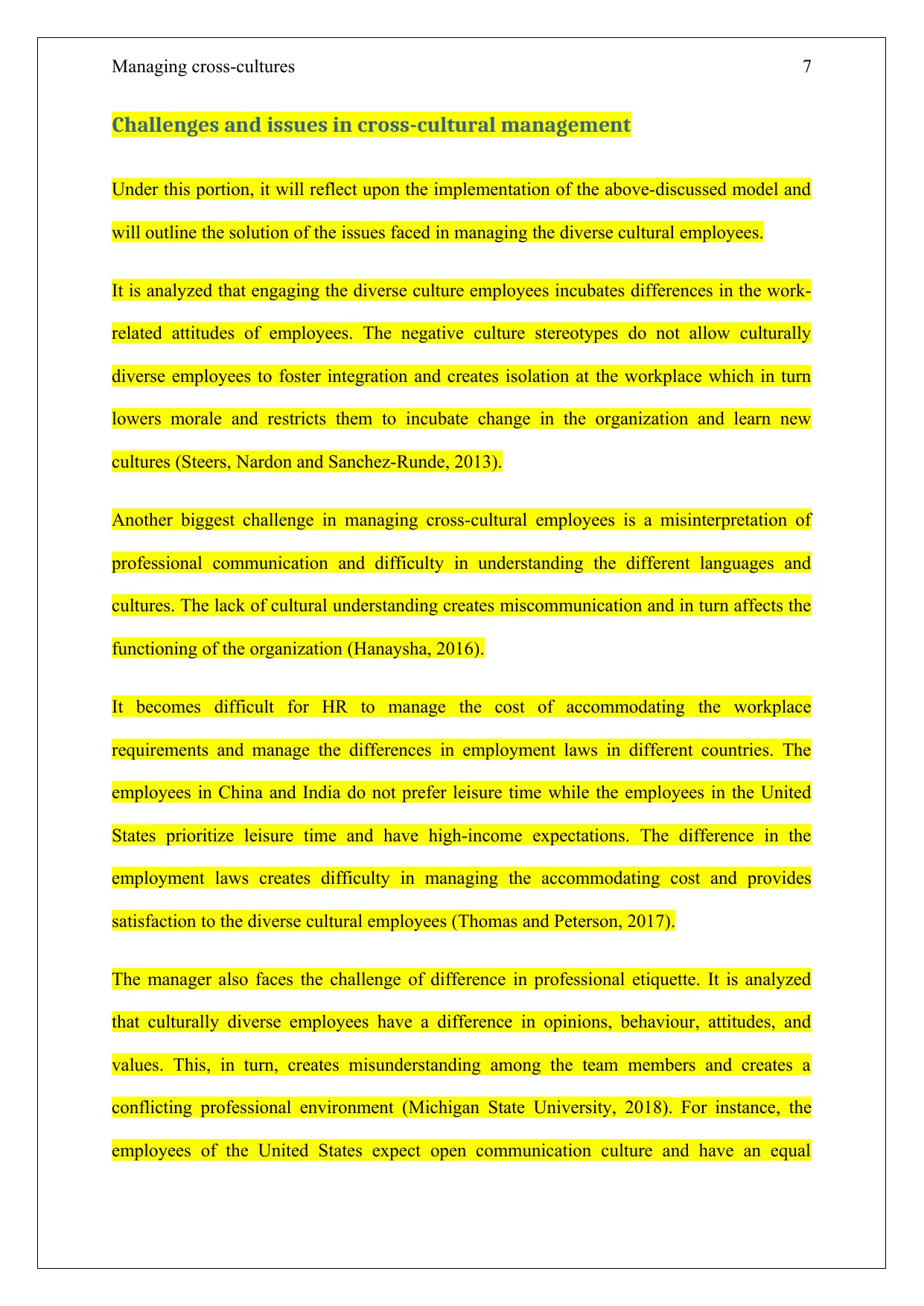
Managing cross-cultures 7
Challenges and issues in cross-cultural management
Under this portion, it will reflect upon the implementation of the above-discussed model and
will outline the solution of the issues faced in managing the diverse cultural employees.
It is analyzed that engaging the diverse culture employees incubates differences in the work-
related attitudes of employees. The negative culture stereotypes do not allow culturally
diverse employees to foster integration and creates isolation at the workplace which in turn
lowers morale and restricts them to incubate change in the organization and learn new
cultures (Steers, Nardon and Sanchez-Runde, 2013).
Another biggest challenge in managing cross-cultural employees is a misinterpretation of
professional communication and difficulty in understanding the different languages and
cultures. The lack of cultural understanding creates miscommunication and in turn affects the
functioning of the organization (Hanaysha, 2016).
It becomes difficult for HR to manage the cost of accommodating the workplace
requirements and manage the differences in employment laws in different countries. The
employees in China and India do not prefer leisure time while the employees in the United
States prioritize leisure time and have high-income expectations. The difference in the
employment laws creates difficulty in managing the accommodating cost and provides
satisfaction to the diverse cultural employees (Thomas and Peterson, 2017).
The manager also faces the challenge of difference in professional etiquette. It is analyzed
that culturally diverse employees have a difference in opinions, behaviour, attitudes, and
values. This, in turn, creates misunderstanding among the team members and creates a
conflicting professional environment (Michigan State University, 2018). For instance, the
employees of the United States expect open communication culture and have an equal
Challenges and issues in cross-cultural management
Under this portion, it will reflect upon the implementation of the above-discussed model and
will outline the solution of the issues faced in managing the diverse cultural employees.
It is analyzed that engaging the diverse culture employees incubates differences in the work-
related attitudes of employees. The negative culture stereotypes do not allow culturally
diverse employees to foster integration and creates isolation at the workplace which in turn
lowers morale and restricts them to incubate change in the organization and learn new
cultures (Steers, Nardon and Sanchez-Runde, 2013).
Another biggest challenge in managing cross-cultural employees is a misinterpretation of
professional communication and difficulty in understanding the different languages and
cultures. The lack of cultural understanding creates miscommunication and in turn affects the
functioning of the organization (Hanaysha, 2016).
It becomes difficult for HR to manage the cost of accommodating the workplace
requirements and manage the differences in employment laws in different countries. The
employees in China and India do not prefer leisure time while the employees in the United
States prioritize leisure time and have high-income expectations. The difference in the
employment laws creates difficulty in managing the accommodating cost and provides
satisfaction to the diverse cultural employees (Thomas and Peterson, 2017).
The manager also faces the challenge of difference in professional etiquette. It is analyzed
that culturally diverse employees have a difference in opinions, behaviour, attitudes, and
values. This, in turn, creates misunderstanding among the team members and creates a
conflicting professional environment (Michigan State University, 2018). For instance, the
employees of the United States expect open communication culture and have an equal
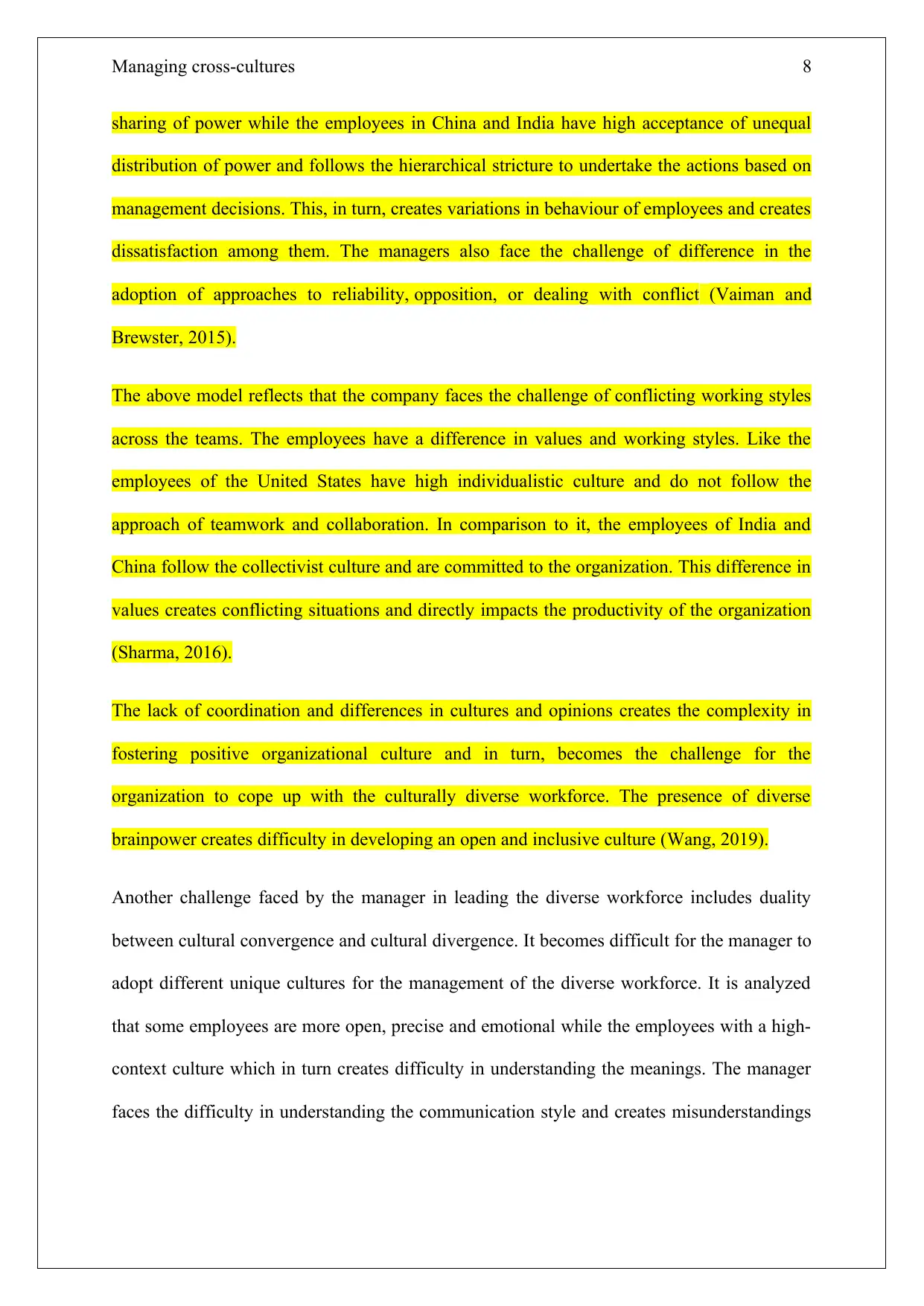
Managing cross-cultures 8
sharing of power while the employees in China and India have high acceptance of unequal
distribution of power and follows the hierarchical stricture to undertake the actions based on
management decisions. This, in turn, creates variations in behaviour of employees and creates
dissatisfaction among them. The managers also face the challenge of difference in the
adoption of approaches to reliability, opposition, or dealing with conflict (Vaiman and
Brewster, 2015).
The above model reflects that the company faces the challenge of conflicting working styles
across the teams. The employees have a difference in values and working styles. Like the
employees of the United States have high individualistic culture and do not follow the
approach of teamwork and collaboration. In comparison to it, the employees of India and
China follow the collectivist culture and are committed to the organization. This difference in
values creates conflicting situations and directly impacts the productivity of the organization
(Sharma, 2016).
The lack of coordination and differences in cultures and opinions creates the complexity in
fostering positive organizational culture and in turn, becomes the challenge for the
organization to cope up with the culturally diverse workforce. The presence of diverse
brainpower creates difficulty in developing an open and inclusive culture (Wang, 2019).
Another challenge faced by the manager in leading the diverse workforce includes duality
between cultural convergence and cultural divergence. It becomes difficult for the manager to
adopt different unique cultures for the management of the diverse workforce. It is analyzed
that some employees are more open, precise and emotional while the employees with a high-
context culture which in turn creates difficulty in understanding the meanings. The manager
faces the difficulty in understanding the communication style and creates misunderstandings
sharing of power while the employees in China and India have high acceptance of unequal
distribution of power and follows the hierarchical stricture to undertake the actions based on
management decisions. This, in turn, creates variations in behaviour of employees and creates
dissatisfaction among them. The managers also face the challenge of difference in the
adoption of approaches to reliability, opposition, or dealing with conflict (Vaiman and
Brewster, 2015).
The above model reflects that the company faces the challenge of conflicting working styles
across the teams. The employees have a difference in values and working styles. Like the
employees of the United States have high individualistic culture and do not follow the
approach of teamwork and collaboration. In comparison to it, the employees of India and
China follow the collectivist culture and are committed to the organization. This difference in
values creates conflicting situations and directly impacts the productivity of the organization
(Sharma, 2016).
The lack of coordination and differences in cultures and opinions creates the complexity in
fostering positive organizational culture and in turn, becomes the challenge for the
organization to cope up with the culturally diverse workforce. The presence of diverse
brainpower creates difficulty in developing an open and inclusive culture (Wang, 2019).
Another challenge faced by the manager in leading the diverse workforce includes duality
between cultural convergence and cultural divergence. It becomes difficult for the manager to
adopt different unique cultures for the management of the diverse workforce. It is analyzed
that some employees are more open, precise and emotional while the employees with a high-
context culture which in turn creates difficulty in understanding the meanings. The manager
faces the difficulty in understanding the communication style and creates misunderstandings
⊘ This is a preview!⊘
Do you want full access?
Subscribe today to unlock all pages.

Trusted by 1+ million students worldwide
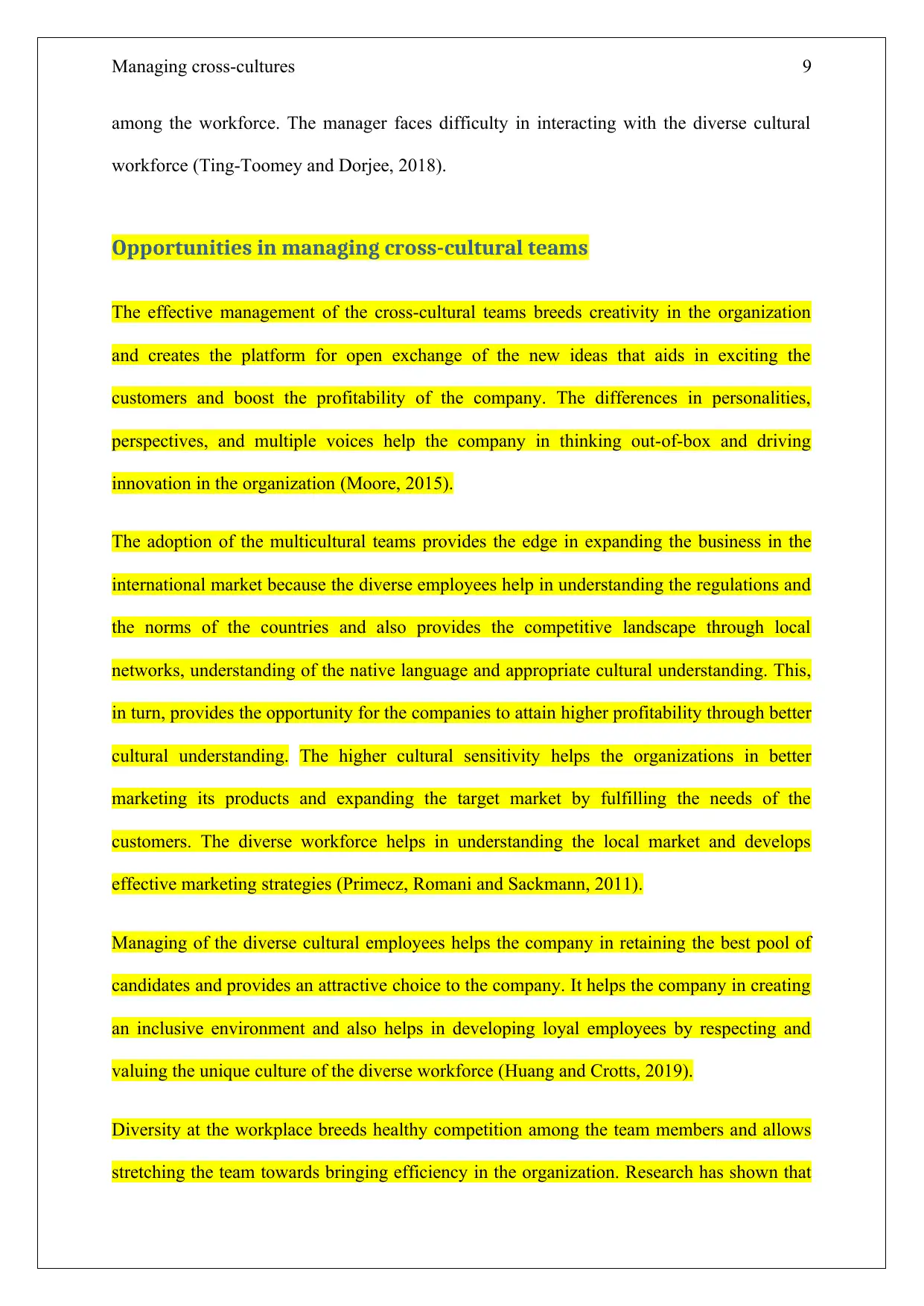
Managing cross-cultures 9
among the workforce. The manager faces difficulty in interacting with the diverse cultural
workforce (Ting-Toomey and Dorjee, 2018).
Opportunities in managing cross-cultural teams
The effective management of the cross-cultural teams breeds creativity in the organization
and creates the platform for open exchange of the new ideas that aids in exciting the
customers and boost the profitability of the company. The differences in personalities,
perspectives, and multiple voices help the company in thinking out-of-box and driving
innovation in the organization (Moore, 2015).
The adoption of the multicultural teams provides the edge in expanding the business in the
international market because the diverse employees help in understanding the regulations and
the norms of the countries and also provides the competitive landscape through local
networks, understanding of the native language and appropriate cultural understanding. This,
in turn, provides the opportunity for the companies to attain higher profitability through better
cultural understanding. The higher cultural sensitivity helps the organizations in better
marketing its products and expanding the target market by fulfilling the needs of the
customers. The diverse workforce helps in understanding the local market and develops
effective marketing strategies (Primecz, Romani and Sackmann, 2011).
Managing of the diverse cultural employees helps the company in retaining the best pool of
candidates and provides an attractive choice to the company. It helps the company in creating
an inclusive environment and also helps in developing loyal employees by respecting and
valuing the unique culture of the diverse workforce (Huang and Crotts, 2019).
Diversity at the workplace breeds healthy competition among the team members and allows
stretching the team towards bringing efficiency in the organization. Research has shown that
among the workforce. The manager faces difficulty in interacting with the diverse cultural
workforce (Ting-Toomey and Dorjee, 2018).
Opportunities in managing cross-cultural teams
The effective management of the cross-cultural teams breeds creativity in the organization
and creates the platform for open exchange of the new ideas that aids in exciting the
customers and boost the profitability of the company. The differences in personalities,
perspectives, and multiple voices help the company in thinking out-of-box and driving
innovation in the organization (Moore, 2015).
The adoption of the multicultural teams provides the edge in expanding the business in the
international market because the diverse employees help in understanding the regulations and
the norms of the countries and also provides the competitive landscape through local
networks, understanding of the native language and appropriate cultural understanding. This,
in turn, provides the opportunity for the companies to attain higher profitability through better
cultural understanding. The higher cultural sensitivity helps the organizations in better
marketing its products and expanding the target market by fulfilling the needs of the
customers. The diverse workforce helps in understanding the local market and develops
effective marketing strategies (Primecz, Romani and Sackmann, 2011).
Managing of the diverse cultural employees helps the company in retaining the best pool of
candidates and provides an attractive choice to the company. It helps the company in creating
an inclusive environment and also helps in developing loyal employees by respecting and
valuing the unique culture of the diverse workforce (Huang and Crotts, 2019).
Diversity at the workplace breeds healthy competition among the team members and allows
stretching the team towards bringing efficiency in the organization. Research has shown that
Paraphrase This Document
Need a fresh take? Get an instant paraphrase of this document with our AI Paraphraser
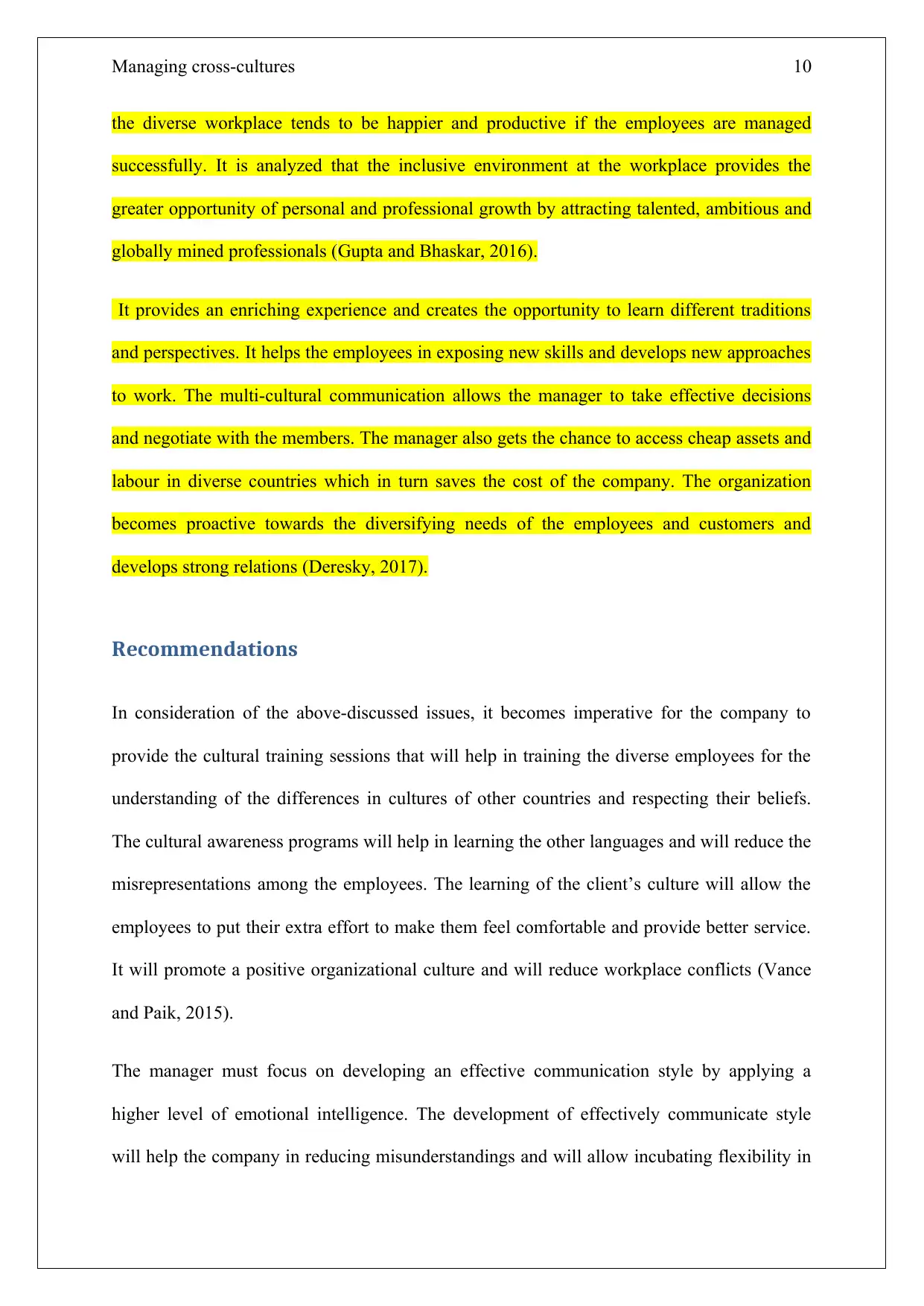
Managing cross-cultures 10
the diverse workplace tends to be happier and productive if the employees are managed
successfully. It is analyzed that the inclusive environment at the workplace provides the
greater opportunity of personal and professional growth by attracting talented, ambitious and
globally mined professionals (Gupta and Bhaskar, 2016).
It provides an enriching experience and creates the opportunity to learn different traditions
and perspectives. It helps the employees in exposing new skills and develops new approaches
to work. The multi-cultural communication allows the manager to take effective decisions
and negotiate with the members. The manager also gets the chance to access cheap assets and
labour in diverse countries which in turn saves the cost of the company. The organization
becomes proactive towards the diversifying needs of the employees and customers and
develops strong relations (Deresky, 2017).
Recommendations
In consideration of the above-discussed issues, it becomes imperative for the company to
provide the cultural training sessions that will help in training the diverse employees for the
understanding of the differences in cultures of other countries and respecting their beliefs.
The cultural awareness programs will help in learning the other languages and will reduce the
misrepresentations among the employees. The learning of the client’s culture will allow the
employees to put their extra effort to make them feel comfortable and provide better service.
It will promote a positive organizational culture and will reduce workplace conflicts (Vance
and Paik, 2015).
The manager must focus on developing an effective communication style by applying a
higher level of emotional intelligence. The development of effectively communicate style
will help the company in reducing misunderstandings and will allow incubating flexibility in
the diverse workplace tends to be happier and productive if the employees are managed
successfully. It is analyzed that the inclusive environment at the workplace provides the
greater opportunity of personal and professional growth by attracting talented, ambitious and
globally mined professionals (Gupta and Bhaskar, 2016).
It provides an enriching experience and creates the opportunity to learn different traditions
and perspectives. It helps the employees in exposing new skills and develops new approaches
to work. The multi-cultural communication allows the manager to take effective decisions
and negotiate with the members. The manager also gets the chance to access cheap assets and
labour in diverse countries which in turn saves the cost of the company. The organization
becomes proactive towards the diversifying needs of the employees and customers and
develops strong relations (Deresky, 2017).
Recommendations
In consideration of the above-discussed issues, it becomes imperative for the company to
provide the cultural training sessions that will help in training the diverse employees for the
understanding of the differences in cultures of other countries and respecting their beliefs.
The cultural awareness programs will help in learning the other languages and will reduce the
misrepresentations among the employees. The learning of the client’s culture will allow the
employees to put their extra effort to make them feel comfortable and provide better service.
It will promote a positive organizational culture and will reduce workplace conflicts (Vance
and Paik, 2015).
The manager must focus on developing an effective communication style by applying a
higher level of emotional intelligence. The development of effectively communicate style
will help the company in reducing misunderstandings and will allow incubating flexibility in
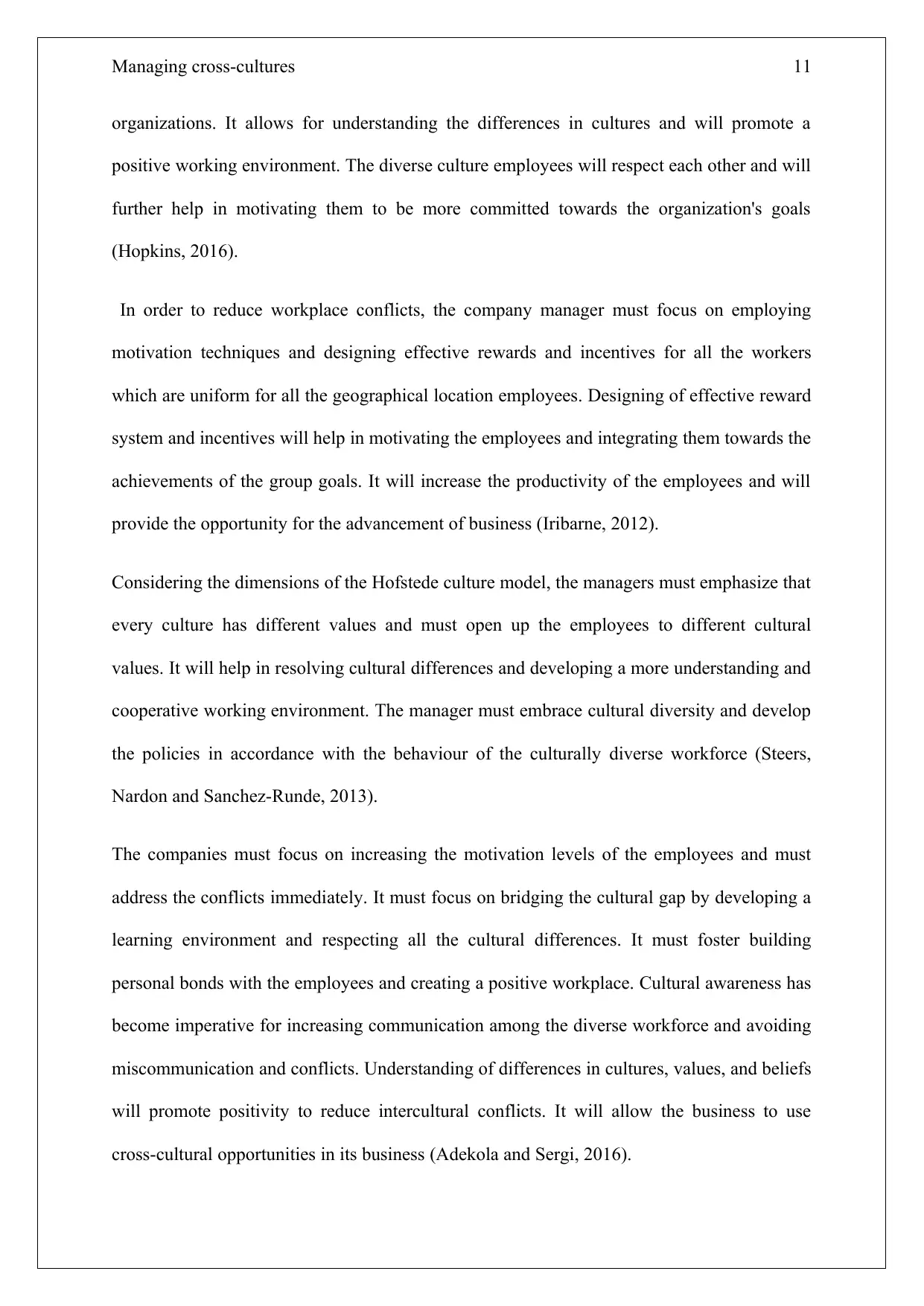
Managing cross-cultures 11
organizations. It allows for understanding the differences in cultures and will promote a
positive working environment. The diverse culture employees will respect each other and will
further help in motivating them to be more committed towards the organization's goals
(Hopkins, 2016).
In order to reduce workplace conflicts, the company manager must focus on employing
motivation techniques and designing effective rewards and incentives for all the workers
which are uniform for all the geographical location employees. Designing of effective reward
system and incentives will help in motivating the employees and integrating them towards the
achievements of the group goals. It will increase the productivity of the employees and will
provide the opportunity for the advancement of business (Iribarne, 2012).
Considering the dimensions of the Hofstede culture model, the managers must emphasize that
every culture has different values and must open up the employees to different cultural
values. It will help in resolving cultural differences and developing a more understanding and
cooperative working environment. The manager must embrace cultural diversity and develop
the policies in accordance with the behaviour of the culturally diverse workforce (Steers,
Nardon and Sanchez-Runde, 2013).
The companies must focus on increasing the motivation levels of the employees and must
address the conflicts immediately. It must focus on bridging the cultural gap by developing a
learning environment and respecting all the cultural differences. It must foster building
personal bonds with the employees and creating a positive workplace. Cultural awareness has
become imperative for increasing communication among the diverse workforce and avoiding
miscommunication and conflicts. Understanding of differences in cultures, values, and beliefs
will promote positivity to reduce intercultural conflicts. It will allow the business to use
cross-cultural opportunities in its business (Adekola and Sergi, 2016).
organizations. It allows for understanding the differences in cultures and will promote a
positive working environment. The diverse culture employees will respect each other and will
further help in motivating them to be more committed towards the organization's goals
(Hopkins, 2016).
In order to reduce workplace conflicts, the company manager must focus on employing
motivation techniques and designing effective rewards and incentives for all the workers
which are uniform for all the geographical location employees. Designing of effective reward
system and incentives will help in motivating the employees and integrating them towards the
achievements of the group goals. It will increase the productivity of the employees and will
provide the opportunity for the advancement of business (Iribarne, 2012).
Considering the dimensions of the Hofstede culture model, the managers must emphasize that
every culture has different values and must open up the employees to different cultural
values. It will help in resolving cultural differences and developing a more understanding and
cooperative working environment. The manager must embrace cultural diversity and develop
the policies in accordance with the behaviour of the culturally diverse workforce (Steers,
Nardon and Sanchez-Runde, 2013).
The companies must focus on increasing the motivation levels of the employees and must
address the conflicts immediately. It must focus on bridging the cultural gap by developing a
learning environment and respecting all the cultural differences. It must foster building
personal bonds with the employees and creating a positive workplace. Cultural awareness has
become imperative for increasing communication among the diverse workforce and avoiding
miscommunication and conflicts. Understanding of differences in cultures, values, and beliefs
will promote positivity to reduce intercultural conflicts. It will allow the business to use
cross-cultural opportunities in its business (Adekola and Sergi, 2016).
⊘ This is a preview!⊘
Do you want full access?
Subscribe today to unlock all pages.

Trusted by 1+ million students worldwide
1 out of 19
Related Documents
Your All-in-One AI-Powered Toolkit for Academic Success.
+13062052269
info@desklib.com
Available 24*7 on WhatsApp / Email
![[object Object]](/_next/static/media/star-bottom.7253800d.svg)
Unlock your academic potential
Copyright © 2020–2025 A2Z Services. All Rights Reserved. Developed and managed by ZUCOL.





